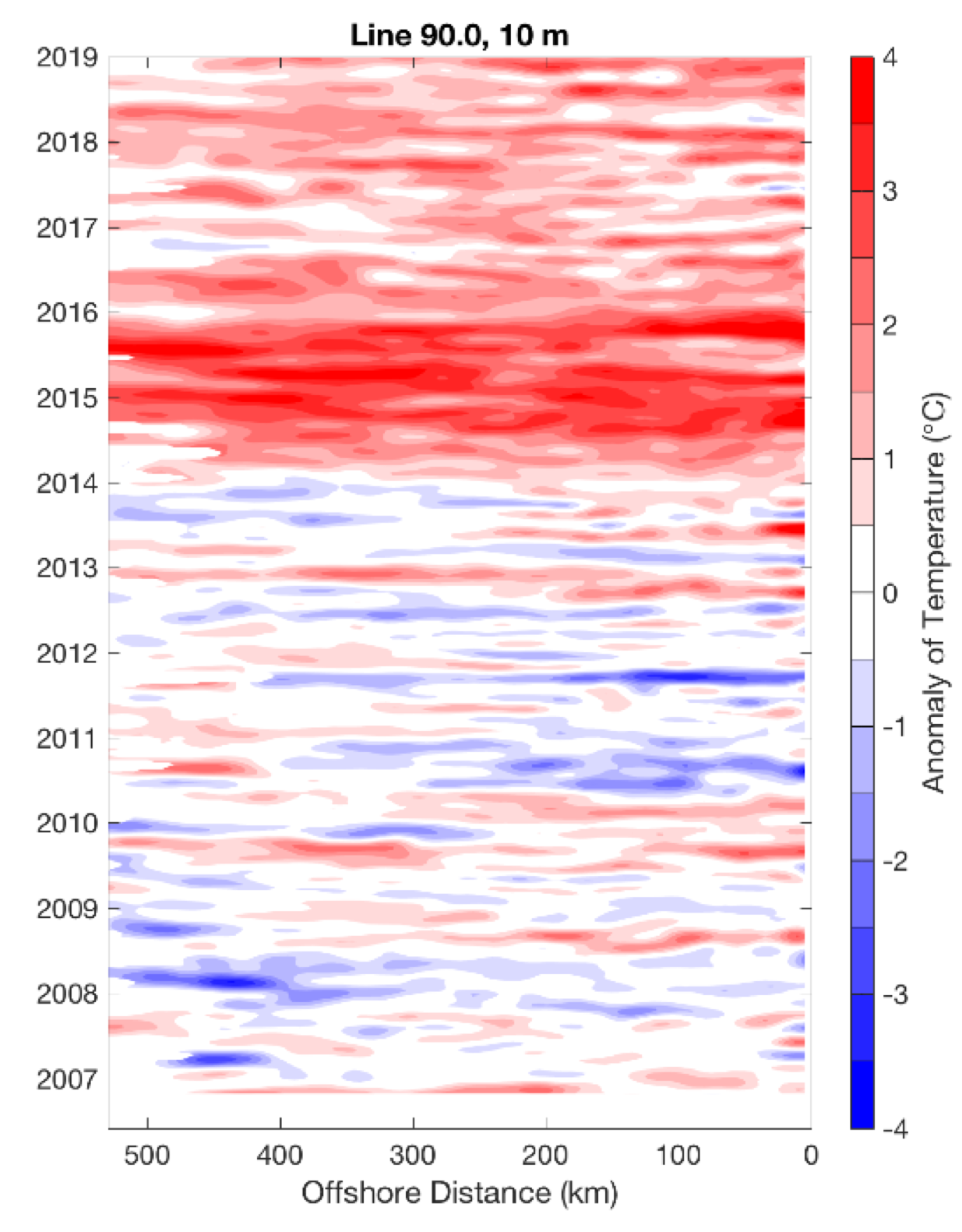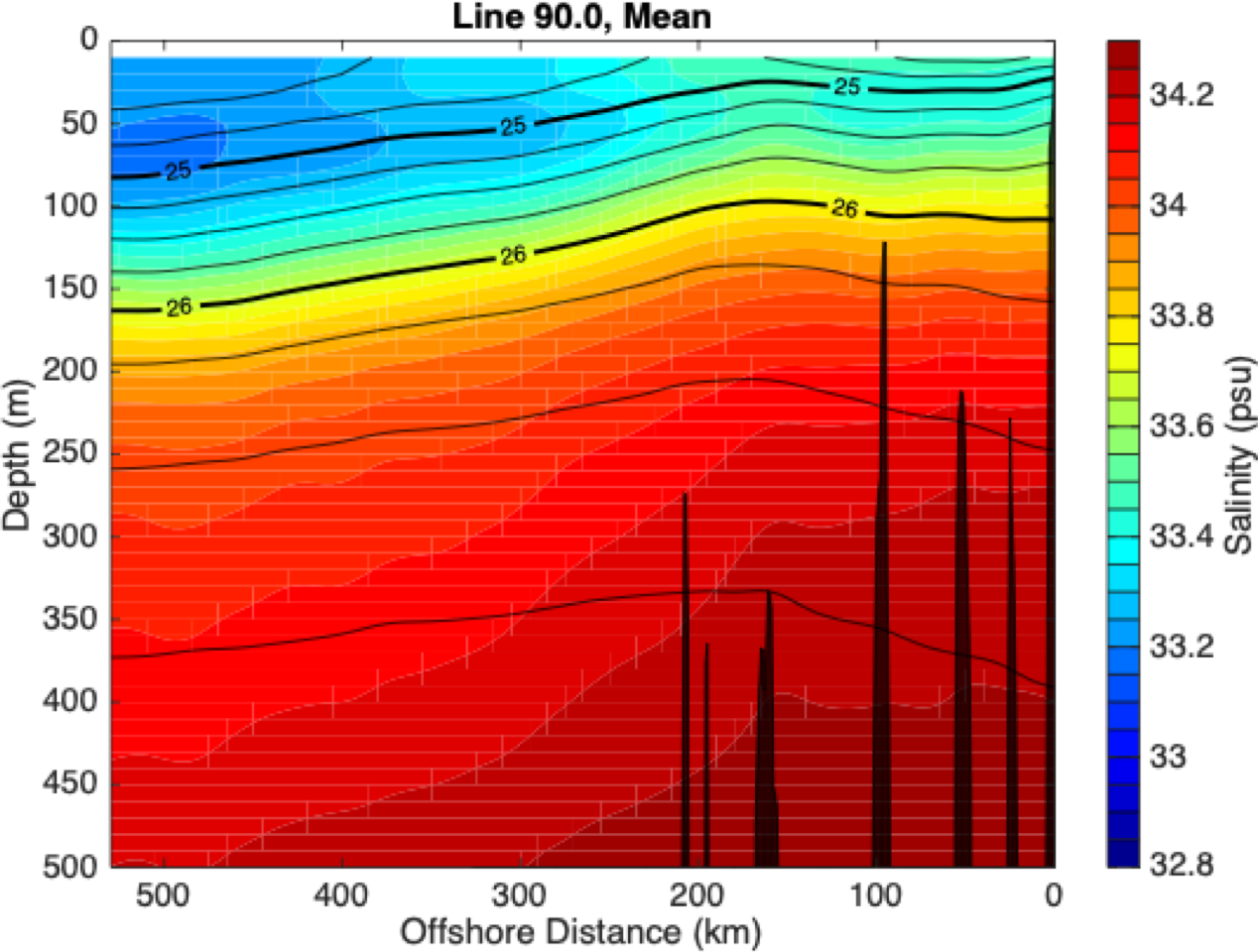Underwater gliders are autonomous vehicles that profile vertically by controlling buoyancy and move horizontally on wings. Using a network of underwater gliders, the overarching goal of this project is to sustain baseline observations of climate variability off the coast of California, including effects on such the oxygen content of local seawater. Gliders also contribute to the response to events such as oil spills, harmful algal blooms, and storms.
Locations
The California Underwater Glider Network (CUGN) uses Spray underwater gliders making repeated dives from the surface to 500 m and back, repeating the cycle every 3 hours, and traveling 3 km in the horizontal during that time. The CUGN includes five gliders lines: three of the sustained traditional cross-shore surveying lines starting in 2005 (off Monterey Bay, Point Conception, and Dana Point) and three new lines (alongshore line, line 56.7, and Trinidad Head Line). The glider missions typically last about 100 days, and cover over 2000 km, thus providing 4-6 sections on lines extending 300-500 km offshore.
You can access and visualize the data on the California Ocean Observing Systems data portal!
1. Climate Variability and Change
The California Current System (CCS) is strongly affected by climate variability generated at the equator by El Niño. The effects of El Niño are felt across the Pacific Basin, and especially in the CCS through changes in the temperature, salinity, and current. These changes are so profound that nearly all users of ocean resources notice, and want information about the magnitude and extent of the effects. Recreational ocean users experience the exceptionally warm water brought by El Niño.
2. Ecosystems and Fisheries
Anomalously warm water in the CCS is largely a result of reduced upwelling, which suppresses the supply of nutrient-rich water to the surface. So, El Niño also results in changes to ocean biota, with some species moving with the water whose conditions they favor, and other species with less ability to move being adversely affected. These changes in sea life affect the livelihood of fishers, and the general public is sensitive to the exotic species washed up on beaches and the devastation to some local species.

3. Water Quality
Harmful Algal Bloom (HAB) Research: The Southern California Coastal Ocean Observing System’s (SCCOOS) network of HAB monitoring and forecasting provides an operational warning system for HAB events. Monitoring HABs throughout the state of California can prevent human illness by providing an early warning system for fisheries and for marine mammal stranding networks. Advanced warning of HABs informs managers, researchers, and the public on environmental and economic threats. Gliders inform researchers about the subsurface origin of HABs. In addition, gliders provide information on thin (cryptic) layers of phytoplankton where refuge HAB populations often reside. Another application of glider data being used for HAB research is to better understand the bio-physical coupling associated with upwelling events and advection. These bio-physical processes are the drivers of the food web in Southern California.

Ocean Acidification Monitoring: Since the industrial revolution began, the concentration of carbon dioxide (CO2) in the atmosphere has increased due to the burning of fossil fuels and land-use change. During this time, the pH of surface ocean waters has fallen by 0.1 pH units. This change represents an approximately 30 percent increase in acidity of the oceans. Gliders measure dissolved oxygen which aids in ocean acidification monitoring and research and is associated with changes in pH as well as broad changes in the circulation of the world’s oceans.
4. Marine Operations
Oil Spill Response: On May 19, 2015, an oil pipeline ruptured onto Refugio State Beach, spilling 101,000 gallons of crude oil. This is enough oil to fill an average house (40’x40’x8’) (NOAA). Gliders were part of the suite of critical observations used to inform response managers on water column ocean currents, temperature, salinity, oxygen, and more. These data were used to analyze the trajectory and impacts of the spill
The application of glider observations proves critical for mitigating impacts on human health, the economy, and the environment. Our products continue to evolve to meet the needs of our diverse users ranging from state and federal government agencies to private industry, the public and more.
Data Access
- SCCOOS Data Portal
- ERDDAP (real time)
- GTS
- CUGN (delayed mode)
Principal Investigator
Dan Rudnick, UCSD - drudnick@ucsd.edu
Publications
Rudnick, D. L., K. D. Zaba, R. E. Todd, and R. E. Davis, 2017: A climatology of the California Current System from a network of underwater gliders. Progress in Oceanography, 154, 64-106; doi: 10.1016/j.pocean.2017.03.002
Zaba, K. D., D. L. Rudnick, B. D. Cornuelle, G. Gopalakrishnan, and M. R. Mazloff, 2018: Annual and interannual variability in the California Current System: Comparison of an assimilating state estimate with a network of underwater gliders. Journal of Physical Oceanography, 48, 2965-2988, doi: 10.1175/JPO-D-18-0037.1.
Chao, Y., J. D. Farrara, H. C. Zhang, K. J. Armenta, L. Centurioni, F. Chavez, J. B. Girton, D. Rudnick, and R. K. Walter, 2018: Development, implementation, and validation of a California coastal ocean modeling, data assimilation, and forecasting system. Deep-Sea Research Part Ii-Topical Studies in Oceanography, 151, 49-63, doi: 10.1016/j.dsr2.2017.04.013.
Itoh, S. and D. L. Rudnick, 2017: Fine-scale variability of isopycnal salinity in the California Current System. Journal of Geophysical Research-Oceans, 122, 7066-7081, doi: 10.1002/2017JC013080.
Jacox, M. G., Hazen, E. L., Zaba, K. D., Rudnick, D. L., Edwards, C. A., Moore, A. M., & Bograd, S. J. 2016: Impacts of the 2015–2016 El Niño on the California Current System: Early assessment and comparison to past events. Geophysical Research Letters, 43(13), 7072-7080; doi: 10.1002/2016GL069716
Zaba, K. D., & Rudnick, D. L. 2016: The 2014–2015 warming anomaly in the Southern California Current System observed by underwater gliders. Geophysical Research Letters, 43(3), 1241-1248; doi: 10.1002/2015GL067550
Funding
- Southern California Coastal Ocean Observing System (SCCOOS)
- NOAA Ocean Observing and Monitoring Division

